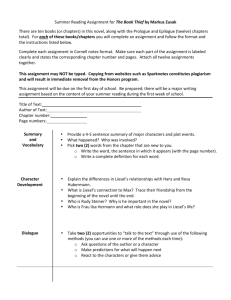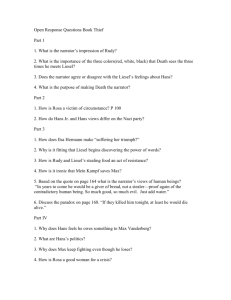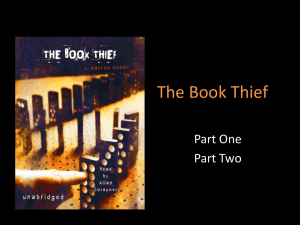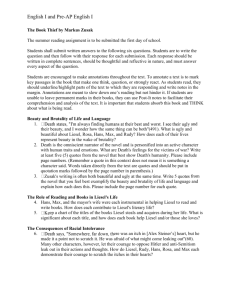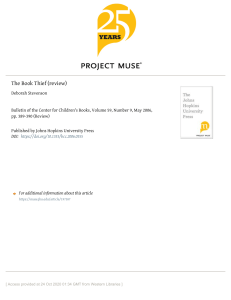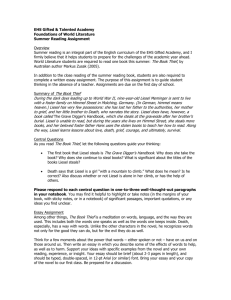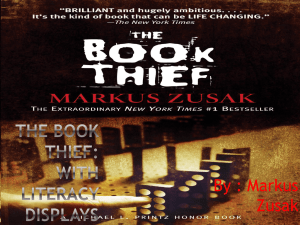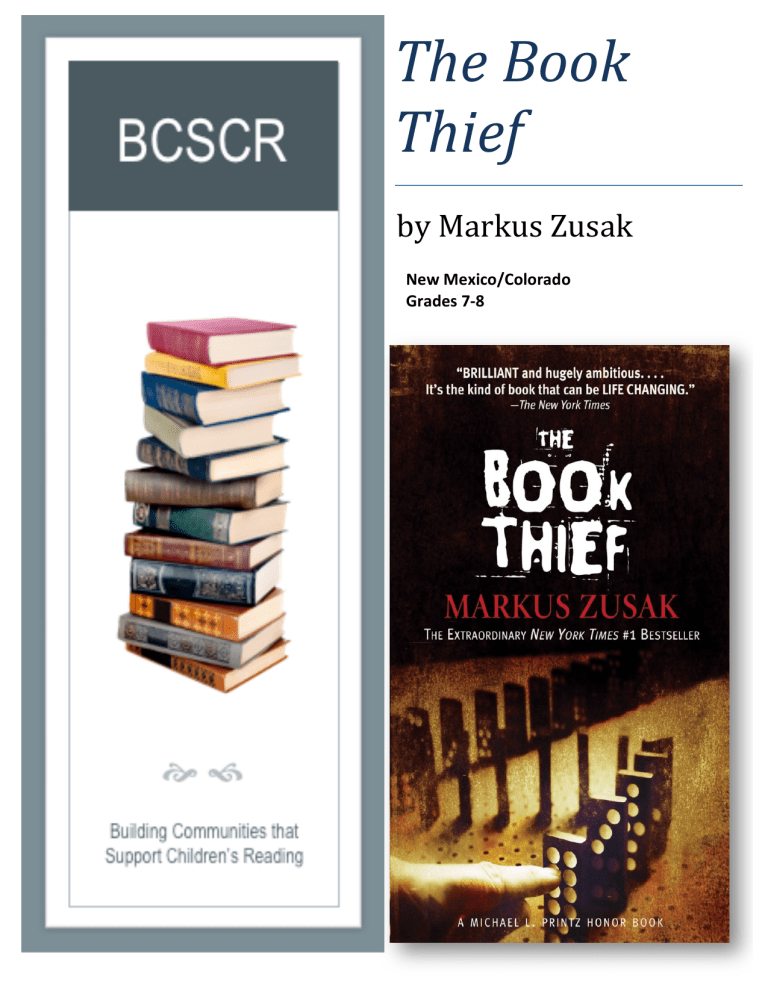
The Book Thief by Markus Zusak New Mexico/Colorado Grades 7-­‐8 Contents The Book Thief Synopsis & Standards High Level Questions Vocabulary Introduction Vocabulary Literary Devices Using Choice Boards Choice Board – The Secret Life of Bees Choice Board Template Raft Introduction RAFT – The Secret Life of Bees Background Information Extension Activities 1 -­‐ 1a 2 -­‐ 2j 3 3a -­‐ 3j 4 -­‐ 4e 5 5a 5b 6 6a 7 -­‐ 7b 8 -­‐ 8b Synopsis The Book Thief Liesel Meminger, a nine-­‐year-­‐old girl living in Germany during World War II is the focus of this novel, and her experiences are narrated by Death, who details both the beauty and destruction that this time period brought. After her brother's death, Liesel arrives in a troubled state at the home of her new foster parents, Hans and Rosa Hubermann. During her time there, she is exposed to the horror of the Nazi regime and battles to find a way to maintain the innocence of her childhood in the midst of her destructive surroundings. After discovering the power of writing and sharing the written word, Liesel begins to not only steal the books that the Nazi party is looking to destroy, but to also write her own stories and share the power of language with Max, the Jewish refugee. As Liesel copes with the trauma of her past and the violent horrors of the war-­‐torn world around her, she embarks on a journey of self-­‐discovery, the formation of a new family, and mostly, her life as "the book thief." New Mexico and Colorado Common Core State Standards RL.7-­‐8.1: I can cite strong and thorough textual evidence to support analysis of what the text says explicitly as well as inferences drawn from the text. RL. 7-­‐8.2 I can determine a theme or central idea of a text and analyze in detail its development over the course of the text, including how it emerges and is shaped and refined by specific details; provide an objective summary of the text. RL. 7-­‐8.3 I can analyze how complex characters (e.g., those with multiple or conflicting motivations) develop over the course of a text, interact with other characters, and advance the plot or develop the theme. RL. 7-­‐8.4 I can determine the meaning of words and phrases as they are used in the text, including figurative and connotative meanings; analyze the cumulative impact of specific word choices on meaning and tone (e.g., how the language evokes a sense of time and place; how it sets a formal or informal tone). RL. 7-­‐8.5 I can analyze how an author's choices concerning how to structure a text, order events within it (e.g., parallel plots), and manipulate time (e.g., pacing, flashbacks) create such effects as mystery, tension, or surprise. RI. 7-­‐8.3 I can analyze how the author unfolds an analysis or series of ideas or events, including the order in which the points are made, how they are introduced and developed, and the connections that are drawn between them. RI. 7-­‐8.6 I can determine an author's point of view or purpose in a text and analyze how an author uses rhetoric to advance that point of view or purpose. 1 The Book Thief W.7-­‐8.1 I can write arguments to support claims in an analysis of substantive topics or texts, using valid reasoning, relevant, and sufficient evidence. W.7-­‐8.3 I can write narratives to develop real or imagined experiences or events using effective technique, well-­‐chosen details, and well-­‐structured event sequences. W. 7-­‐8.4 I can produce clear and coherent writing in which the development, organization, and style are appropriate to task, purpose, and audience. W. 7-­‐8.6 I use technology to produce, publish, and display information flexibly and dynamically. W. 7-­‐8.7 I conduct short as well as more sustained research projects to answer a question (including a self-­‐generated question) or solve a problem; narrow or broaden the inquiry when appropriate; synthesize multiple sources on the subject, demonstrating understanding of the subject under investigation. W. 7-­‐8.9 I draw evidence from literary or informational texts to support analysis, reflection, and research. SL. 7-­‐8.4 I can present information, findings, and supporting evidence clearly, concisely, and logically such that listeners can follow the line of reasoning and the organization, development, substance, and style are appropriate to purpose, audience, and task. SL. 7-­‐8.5 I can make strategic use of digital media (e.g., textual, graphical, audio, visual, and interactive elements) in presentations to enhance understanding of findings, reasoning, and evidence and to add interest. 1a High Level Questions The Book Thief Prologue 1. Death, the narrator, finds his duties painful. Cite textual evidence showing why Death feels this way. 2. Death describes the way he sees colors. Why are colors important to Death? 3. According to Death, who are “the left behind,” the survivors? 4. Death recalls, “As for me, I had already made the most elementary of mistakes. ” (p. 7) Summarize Death’s mistake. 5. Death communicates to the reader that he saw the book thief three times. The chapters in the prologue titled Beside the Railway Line; The Eclipse; and The Flag give a description of the three times he saw her. Briefly describe each of the three times he saw her. 6. “When I recollect [the book thief], I see a long list of colors, but it’s the three in which I saw her in the flesh that resonate the most.” (p. 14). What are the colors which he sees for her? In your opinion, what do these colors symbolize? 2 The Book Thief Part One 1. Why are the book thief and her brother traveling on a train? 2. What role does Death play in Werner’s death? 3. Death says, “Mistakes, mistakes, it’s all I seem capable of.” (p. 23). Cite evidence of Death’s mistakes. 4. Liesel would not get out of the car once on Himmel Street. What role did Hans Hubermann play in getting her to go into the house? 5. The author foreshadows the books thief’s stealing career on page 29. Cite textual evidence of this foreshadowing. 6. The author foreshadows Liesel’s future on page 30, and then describes her physical condition on page 31. Describe her condition, and then predict what will become of Liesel from the author’s foreshadowing. 7. Describe Hans Hubermann found on page 34. 8. In your opinion, why couldn’t Rosa show her husband, Hans, and Liesel how she truly felt about them? 9. One of the chapters in Part One is titled, The Woman With the Iron Fist. Cite textual evidence why this chapter holds this title. 10. In your opinion, why did Hans go to Liesel after one of her nightmares instead on Rosa? 11. What might Papa’s accordion be a symbol of? 12. School was a “terrible failure” for Liesel. Why? 13. Page 40 gives a description of Liesel’s school. Contrast her experience of school with your own. 14. Rosa constantly criticizes the people for whom she works. In your opinion, why does she do this? 15. Progress tests were being conducted at Liesel’s school. Liesel wanted to read and told Sister that she was ready and could do it. Sister replied, “No, you cannot!” (p. 76) How do you think this statement made Liesel feel? 16. Death’s workload increased in the beginning of September 1939. Why? 2a The Book Thief Part Two 1. Death reflects, “…it[the act of stealing]would show me, once again that one opportunity leads directly to another, just as risk leads to more risk, life to more life, and death to more death.” (p. 83). How does Death’s statement support the theme? 2. The narrator lets the reader know that Liesel stole the second book because she was so angry. Why is Liesel angry? 3. How did papa pay for Liesel’s Christmas gifts? How does this show Hans’ love for Liesel? 4. A class assignment is to write a letter, and Liesel decides to write a letter to her mother. What is Rosa’s response? Why does she feel this way? 5. Rosa beat Liesel with a wooden spoon for spending some of the laundry money, but Liesel was hurting for another reason. What was that reason? 6. Why was Hans Junior angry with his father? 7. Why is the word communist significant to Liesel? 8. Who saw Liesel take The Shoulder Shrug? 2b The Book Thief Part Three 1. What was Papa’s response to Liesel taking the book, The Shoulder Shrug? 2. Why did Papa buy a copy of Mein Kampf? 3. Why didn’t Liesel want to pick up laundry from the Mayor’s house? 4. What was Liesel’s reaction to seeing the Mayor’s library? Why did she feel this way? 5. Who is Max? What is Max’s relationship to Hans? 6. “The authorities’ problem with [The Shoulder Shrug] was obvious.” (p. 143] Cite textual evidence as to why the authorities had a problem with the German population owning this book. 7. Who is Johann Hermann? Why is he an important part of the mayor’s wife character development? 8. “The depressing pea soup and Rudy’s hunger finally drove them to thievery.” (p. 150). What did Liesel and Rudy steal? 9. “Behind Max Vandenburg, the city of Stuttgart opened its arms in mockery.” (p. 157) Why was Max not welcomed in that city? 10. One of the chapters in Part Three is titled, The Trickster. Why is this an appropriate name for this chapter? 11. Instead of keeping all of the food for themselves, Rudy and Liesel share the food with the group of boys. Why did they share? 12. Liesel and Rudy sold the chestnuts. What did they do with the money? What would you have done with the money? 2c The Book Thief Part Four 1. “The struggler: If they killed him tonight, at least he would be alive.” (p. 168). What is meant by this quote? 2. Why does Max feel that asking people for help is selfish? Use textual evidence. 3. How did Erik Vanderburg save Hans Hubermann’s life in the WWI? 4. Hans’ painting business weakened after 1933. Why? 5. Max and Liesel share a unique bond. What factors helped create this bond? 6. After Max’s arrival to the Hubermann household, Rosa’s behavior changes. What are these changes? 7. Max was a street fighter for many years. How might this have helped him now? 8. What is Hans’ motivation for helping Max? 9. Max created a book for Liesel. What is the significance for the way he made the book? What is the significance of Rosa helping Max? 10. In Max’s book, The Standover Man, there are words scribbled on the wall. What significance do these words have? 2d The Book Thief Part Five 1. The author foreshadows Rudy’s future. What happens to Rudy? Why do you suppose the author decided to tell the reader now? 2. Liesel searches through the garbage on her way to deliver laundry. Why? 3. Max despises time. Why? How does he pass the time in the Hubermann’s basement? 4. Liesel unleashes her fury on the mayor’s wife. Why is she so angry with her? 5. How are the Jews and the mayor’s wife alike? 6. Viktor Chemmel assumed the leadership of the group of thieves. Why didn’t any of the other boys take command? How does Viktor’s character compare to Hitler? 7. Tommy Muller was punished during the Hitler Youth drill. Why was he punished? How does this speak to character of the Hitler Youth leaders? 8. Cite textual evidence that shows how the German population is suffering at the hands of the Nazi regime. 2e The Book Thief Part Six 1. Summarize Death’s description of 1942. 2. The narrator reflects, “They say that war is death’s best friend, but I must offer you a different point of view on that one.” (p. 309) What is Death’s point of view? How might this point of view differ from “war is death’s best friend?” 3. Describe the snow in the basement episode. In your opinion, was this the reason for Max’s sickness? 4. An excerpt from The Whistler: “[The whistler] talked to people and fooled them into liking him, trusting hm. He talked to them while he was killing them, torturing and turning the knife.” (p. 324) Why might The Whistler be an important novel for Liesel to have found? 5. Liesel just broke into the mayor’s library and stole a book. Rudy wonders why in the world people would leave their windows open. Death offers this, “Or maybe there was a woman on Grande Strasse who now kept her library window open for another reason…” What is Death implying? 6. Mama goes to Liesel’s school to secretly tell her about Max waking up. Mama gives her a toy soldier. For what might the soldier be a symbol? Why does Mama go through all of the trouble? 2f The Book Thief Part Seven 1. Liesel and Papa Hubermann experienced a short-­‐term moment of contentment during the summer of 1942. What was the cause of this contentment? 2. Rudy’s passion is athletic competition. Why is this important to him? 3. Ilse Hermann gave Liesel permission to steal books. Why did Liesel feel that she was a criminal for taking the books? 4. Death did not feel compassion for the Germans who hid in their basements during the air raids. Why? 5. The possible bombing of Molching Place put Max in danger. Why? What would you do if you were in his place? 6. In your opinion, why did Rudy get himself disqualified from the final race of the day? Why do you think he left his medals behind? 7. The author included entries from the dictionary/thesaurus given to Liesel by Ilse Hermann. In your opinion, why do you think the author did this? 8. Why might Death have agreed with Hans that his act of compassion was stupid? 2g The Book Thief Part Eight 1. The coat men wanted Rudy. Why? 2. Rudy and his siblings were playing with the dominoes. “Together, they would watch everything that was so carefully planned collapse, and they would all smile at the beauty of destruction.” (p. 408) For what might the dominoes be a metaphor? 3. Why didn’t Rudy’s parents want him to go with the coat men? 4. If Rudy had volunteered to go with the coat men, how might his life have changed? 5. Why were Alex Steiner and Hans Hubermann drafted? 6. Liesel witnesses Mama with the accordion. Why is Mama fixated with the accordion? 7. In your opinion, why were Hans Hubermann’s letters to home so short in length? 8. Describe Alex’s job in the army. 9. Describe Hans’s job in the army. Who was in the most undesirable position? 10. Rudy went from stealing apples to handing out bread. What made this change in him? 11. Rosa gave Liesel Max’s book. “There was also great longing to tell Rosa Hubermann that she loved her. It’s a shame she didn’t say it.” (p. 443). In your opinion, why didn’t Liesel say she loved her? 12. Max wrote, “THE BEST word shakers were the ones who understood the power of words.” (p. 446) What does Max mean by this? How might words represent both beauty and evil? How might this affect your own life? 13. Why did Liesel take Rudy to his father’s shop on Christmas night? Why did she decide to not kiss him? 14. Predict what will happen in Part Nine. 2h The Book Thief Part Nine 1. How did Ilse Hermann prepare for Liesel’s next visit? 2. Why was Liesel surprised that the library was the mayor’s wife’s room? 3. What events led Hans Huberman to change seats on the military vehicle? 4. What devastating news did Michael Holtzapfel bring to Himmel Street? 5. In your opinion, why did Frau Holtzapfel want Liesel to come over and read after she just found out her son died? 6. The Ageless Brother is the title of one of the chapters in Part Nine. Why do you think the author gave this chapter that name? 7. Hans Hubermann was kind and civil during his assignment in the Army. How might his actions have saved his life? 8. Frau Holtzapfel will not leave her house during the raid. Her son, Michael, leaves to take shelter and says to Rosa, “Tell me, Rosa, how can she sit there ready to die while I still want to live?” (p. 417) Why do you think Frau wants to die when she still has a son? Why does Michael want to live? 9. Liesel is observing the dying survivor of the plan crash when Death reveals, “She did not back away or try to fight me, but I know that something told the girl I was there…but she knew me and she looked me in my face and she did not look away.” (p. 420) What did Death mean by this? What does this tell us about Liesel? 10. In your opinion, why did Rudy give the teddy bear to the “enemy”? 2i The Book Thief Part Ten 1. Liesel survived the air strike on Himmel Street. How did words save her life? 2. Why did Michael Heltzapfel kill himself? 3. Why do you suppose Liesel risked her life to talk to Max? 4. Liesel and Rudy are sitting together, and she shows him The Word Shaker just after she reveals the secret of Max. For the first time, Liesel comes to terms with her feelings for Rudy. Soon after, the author foreshadows Rudy’s death. Why, in your opinion, did the author choose to let the reader know of Rudy’s demise at this time? 5. Liesel crosses the bridge over the Amper River. “The water was glorious and emerald and rich. She could see the stones at the bottom and hear the familiar song of water. The world did not deserve such a river.” (p. 520) Why does Liesel feel this way? 6. In the chapter titled Ilsa Hermann’s Little Black Book, Liesel has a love-­‐hate relationship with words. Cite textual evidence that proves this to be true. 7. Why did Frau Hermann visit Liesel? What does this tell you about the feelings Frau has for Liesel? 8. Liesel decides to write her own story. What caused her to do this? 9. Liesel started writing her story and she reveals, “Words are so heavy…” (p. 526) What does she mean by this? 10. On page 532, describe Death’s portrayal of Rosa. 11. Liesel finds Rudy’s body and kisses him. “He tasted like regret in the shadows of trees and in the glow of the anarchist’s suit collection.” (p. 536) What does she mean by this? 12. Why did Death take The Book Thief instead of leaving it in the garbage truck? Epilogue 1. What motivated Ilsa Hermann to take Liesel? 2. The last note from the narrator was, “I am haunted by humans.” (p. 550) What does Death mean? Why is this ironic? 3. Why is Max the unexpected survivor of the war? 2j Vocabulary Introduction The Book Thief A selection of vocabulary words are identified for each reading section. The vocabulary meanings are according to the context of the writing. You may want to either add to this list or decrease it depending on your students. You can decide whether to introduce vocabulary before reading the section, during, or after. Vocabulary activities could include giving the word and definition, and then having the students give the definition in their own words, drawing a picture of what the particular word means to them, including a synonym/antonym, the part of speech, etc. The students may also write original sentences using the vocabulary words, finding the words on the pages and making a guess based on context clues. Students may be quizzed on each section of words, assigned to write their own stories with vocabulary words, or allowed to play games to reinforce word meanings. 3 Vocabulary The Book Thief Prologue hindered delayed protestations declarations amiable agreeable; affable genially pleasantly abhorrence loathing; disgust versatility resourcefulness; flexibility trepidation fear; anxiety legion crowd; mass septic infected; poisoned 3a Vocabulary The Book Thief Part One: The Grave Digger torrent gush; flow unsavory distasteful; unpleasant apprentice beginner innocuously harmlessly echelons levels enviable fortunate illustrious well-­‐known hiatus break eventuated occur as a result vehement intense prolific abundant castigate criticize deluge flood stupefying amazing atrocious brutal audacious daring nefarious wicked; evil 3b Vocabulary The Book Thief Part Two: The Shoulder Shrug Part Three: Meing Kampf flippant superficial culminate close; finish prolific productive; creative agitation anxiety; nervousness animosity hatred; resentment transgressor sinner; wrongdoer benign kind pensive thoughtful; reflective 3c Vocabulary The Book Thief Part Four: The Standover Man malignant unkind ostracism exclusion; isolation capitulate surrender morose miserable; depressed dormant inactive abrasive rough trepidation fear blatant obvious 3d Vocabulary The Book Thief Part Five: The Whistler preemptively proactively machinations conspiracies; maneuverings rationed limited; controlled frugal thrifty due to economic reasons envisaged imagined plethora overabundance; excess periphery the edge; on the fringe or boundary castigated criticized; reprimanded debilitate weaken prudently carefully amiably agreeably 3e Vocabulary The Book Thief Part Six: The Dream Carrier surly unfriendly; rude paradox contradiction; inconsistency irreparable permanent; irreversible antithesis opposite; contrast premonition hunch tirade rant trepidation fear; anxiety emphatically definitely disgruntled unhappy awry off-­‐center futile useless desolation misery 3f Vocabulary The Book Thief Part Seven: The Complete Duden Dictionary and Thesaurus depleted used up trilogy three part work of literature formidable difficult; tough; challenging loathsome offensive apprehension hesitation; dread feign pretend immutable undeniable futile useless 3g Vocabulary The Book Thief Part Eight: The Word Shaker rogue scoundrel cannier smarter manic overexcited gargantuan huge abject hopeless renowned well-­‐known bellows the lungs of an accordion disheveled messy undeterred to discourage 3h Vocabulary The Book Thief Part Nine: The Last Human Stranger protruded projected out propaganda disinformation innocuous innocent unfurling unfolding semblance appearance reprimand telling off; lecture consecutive repeated quell muffle 3i Vocabulary The Book Thief Part Ten: The Book Thief catatonic unresponsive blaspheme curse pensive thoughtful pendulum sway detonation explosion bereaved grieving immaculate flawless consolation comfort feigned pretend obliterated destroyed irretrievable irreparable Epilogue exquisite beautiful; delicate trepidation fear 3j Literary Devices The author uses many literary devices throughout the novel. Read the definitions, read the examples, fill in the blank, and then write why you chose the specific literary device. Personification: Giving human-­‐like characteristics to non-­‐living things. Simile: Comparing two things using “like” or “as”. Metaphor: Comparing two things not using “like” or “as”. Prologue: 1. “What will the sky be saying?” (p. 4) Literary Device ______________________________ Why? ____________________________________ 2. “…I witness the ones who are left behind, crumbling among the jigsaw puzzle of realization, despair, and surprise.” (p. 5) Literary Device ______________________________ Why? ____________________________________ 3. “Trees wore blankets of ice.” (p. 6) Literary Device ______________________________ Why? ____________________________________ 4. “The plane was still coughing. Smoke was leaking from both its lungs.” (p. 9) Literary Device ______________________________ Why? ____________________________________ 5. “The sky was like soup, boiling and stirring.” (p. 12) Literary Device ______________________________ Why? ____________________________________ 6. “The children-­‐voices laughing, and the smiles like salt, but decaying fast.” (p. 12) Literary Device ______________________________ Why? ____________________________________ 7. “The streets were ruptured veins.” (p. 12) Literary Device ______________________________ Why? ____________________________________ 8. Blood steamed till it was dried on the road, and the bodies were stuck there, like driftwood after the flood.” (p. 12) Literary Device ______________________________ Why? ____________________________________ 4 The Book Thief Literary Devices Part One Personification: Giving human-­‐like characteristics to non-­‐living things. Simile: Comparing two things using “like” or “as”. Metaphor: Comparing two things not using “like” or “as”. 1. “A suddenness found its way onto his, which were a corroded brown color and peeling, like old paint.” (p. 20). Literary Device ______________________________ Why? ____________________________________ 2. “The train galloped on.” (p. 20) Literary Device ______________________________ Why? ____________________________________ 3. “…the boy’s spirit was soft and cold, like ice cream.” (p. 21) Literary Device ______________________________ Why? ____________________________________ 4. This time, the train limped through the snowed-­‐in country.” (p. 22) Literary Device ______________________________ Why? ____________________________________ 5. “I traveled the globe, as always, handing souls to the conveyor belt of eternity.” ( p. 23) Literary Device ______________________________ Why? ____________________________________ 6. “The cemetery welcomed me like a friend, and soon, I was with them.” (p. 23) Literary Device ______________________________ Why? ____________________________________ 7. “…the passengers slid out as if from a torn package.” (p. 25) Literary Device ______________________________ Why? ____________________________________ 8. “There is murky snow spread out like carpet.” (p. 27) Literary Device ______________________________ Why? ____________________________________ 4a The Book Thief Literary Devices Parts Two & Three Symbolism: Using animals, elements, things, places, or colors to represent other things. Flashback: A transition in a story to an earlier time, which interrupts the normal chronological order. Cliffhanger: A plot device that leaves the reader in suspense at the end of chapter. 1. “The Shoulder Shrug. It was a blue book with red writing engraved on the cover.” (p. 84) For what might red be a symbol? 2. What does The Grave Digger’s Handbook symbolize? 3. What does finishing The Grave Digger’s Handbook symbolize? 4. Cite textual evidence that supports the author using flashback on page 104. How does this device help the reader? 5. Cite textual evidence that supports a cliffhanger on page 107. Why does the author use this cliffhanger? 6. The author uses personification to give life to flames. “The orange flames waved at the crowd as paper and print dissolved…” (p. 112) What do the flames symbolize? 7. What might the stolen books symbolize? 8. A flashback occurs on page 145. What is it? How does this flashback help the reader? 9. …they noticed Fritz Hammer eating an apple.” (p. 150) What might the apple symbolize? 10. What does the standover man symbolize? 4b The Book Thief Literary Devices Parts Four and Five 1. What does the accordion symbolize? 2. Why do you think the narrator provided a flashback to Hans Hubermann’s WWI experiences? 3. The author uses a simile to describe Max’s voice. “…there was humor in Max Vanderburg’s voice, though its physicality was like friction—like a stone being gently rubbed across a large rock.” (p. 217) What is being compared? Why is this comparison appropriate? 4. What did the dream of Max fighting with the Fuhrer symbolize? 5. Max and his friends painted over the pages of Mein Kampf. What does this symbolize? 6. The author uses personification to give the reader a vivid description of Liesel thinking about Max while she is visiting the mayor’s wife. “As the book quivered in her lap, the secret sat in her mouth. It made itself comfortable. It crossed its legs.” (p. 146). Two things are being personified. What are they? What visualizations does this give the reader? 7. “For Max Vandenburg, there was cool cement and plenty of time to spend with it. The minutes were cruel. Hours were punishing.” (p. 150) The author uses personification to characterize time. How does this help the reader to understand how Max feels about time? 8. “Although the front and back pages were streaked with black tears of print…” (p. 147) What two things are being compared? Why do you think the author used tears as a comparison? Which literary device is this? Why? 4c The Book Thief Literary Devices Parts Six and Seven 1. “They say war is death’s best friend, but I must offer you a different point of view on that one. To me, war is like the new boss who expects the impossible. He stands over your shoulder repeating one thing, incessantly: ‘Get it done, get it done.’ So you work harder. You get the job done. The boss, however, does not thank you. He asks for more.” (p. 309) What two things are being compared? Which literary device is this? Why? 2. What is the cliffhanger at the end of page 324? 3. What is the symbolic significance of the last book Liesel acquired, The Dream Carrier? 4. “The book thief did not retreat. She took a few extra steps and sat down. Her cold hands felt for her sleeves and a sentence dropped from her mouth. ‘He’s not dead yet.’ The words landed on the table and positioned themselves in the middle.” (p. 330) Which literary device is this? Why? 5. “…The sky was yellow, like burning newspaper.” (p. 336) Which literary device is this? Why? 4d The Book Thief Parts Eight -­‐ Epilogue 1. “Even when they made it around the corner, away from the center of the wreckage, the haze of the collapsed building attempted to follow. It was white and warm, and it crept behind them.” (p. 433). What is being personified? 2. What did Rudy’s lined-­‐up dominoes, described at the beginning of Part Eight symbolize? 3. “A bandaged hand fell out of his coat sleeve and cherries of blood were seeping through the wrapping . . . the cherries of blood had grown into plums.” (p. 465). What is being compared? Which literary device is this? Why? 4. …I looked up and saw the tin-­‐can planes. I watched their stomachs open and the bombs drop casually out.” (p. 427) Which literary device is this? Why? 5. In Part Ten, the narrative shifts rapidly between past, present, and future. What effect does this have on the story? 4e Using Choice Boards The Book Thief Choice boards give students the opportunity to participate in multiple tasks that allow them to practice skills they’ve learned in class or to demonstrate and extend their understanding of concepts. From the board, students either choose or are assigned tasks to complete. Individual tasks address the grade level specific Common Core State Standards and also learning style modalities. To scaffold the activities for struggling readers, teachers can modify the tasks using the blank template provided or give more details for performance criteria. Some teachers like to assign point values for the different tasks. In order to support teachers, the choice boards developed for BCSCR are coded for specific Common Core State Standards. 5 Choice Board The Book Thief Create an illustrated book, as Max Choose two characters, and then With a partner, write a did, that tells in simple language create a collage of the characters’ screenplay about Liesel’s life from and line drawings about someone characteristics using words and the time she reunites with Max you admire. images. until the time of her death. Perform your work for the class. CCSS 7-­‐8.RL.10 CCSS 7-­‐8.W.1 CCSS 7-­‐8.SL.4 Research Holocaust survivors. Create a map of Europe and plot Select five adjectives that points of interest. Write a short characterize Death and give an Find three survivors who interest summary of why these points are example of his commentary in the you and write a short important. novel that illustrates each characterization of each survivor. character trait. Present the information to your class. CCSS 7-­‐8.SL.5 Research the purposes and Give a presentation to the class CCSS 7-­‐8.RL.1 Analyze Liesel’s character and CCSS 7-­‐8.W.6 There are many themes show how she develops over the throughout this novel. Consider course of the novel, how she each theme and discuss how each interacts with other characters, is developed in the novel: • Individual identity vs. social and how she advances the expectations Give an oral presentation to your development of the theme. • Coming to terms with class with the use of visual abandonment and loss representations. Creatively display the analysis • Forming relationships with through the use of technology. others organization of concentration camps in Germany and Eastern Europe. • CCSS 7-­‐8.W.7 • • CCSS 7-­‐8 RL.3 Concern with self vs. concern for others The power of words Overcoming stereotypes CCSS 7-­‐8.RL.2 5a Choice Board 5b Using a RAFT Matrix The Book Thief A RAFT matrix enhances students’ comprehension of novels they’re reading and information they’re learning. It also provides a fun way to encourage student writing. RAFT is an acronym for role, audience, format, and topic: • Role. The role is the person or people the student becomes for this project. Sometimes students take on the role of a book character, historical figure, or contemporary personality, such as Peyton Manning, and at other times, they are themselves. • Audience. The audience is the person or people who will read or view this project. They may include students, teachers, parents, or community members, as well as simulated audiences, such as book characters and historical personalities. • Format. The format is the genre or activity that students create. It might be a letter, brochure, cartoon, journal, poster, essay, newspaper article, speech, or digital scrapbook. • Topic. The topic pertains to the book. It may be an issue related to the book, an essential question, or something of personal interest. RAFT is an effective way to differentiate instruction by providing tiered activities. The BSCSR RAFT matrices are scaffolded and can be adjusted according to students’ achievement levels, English proficiency, and interests. 6 RAFT Matrix The Book Thief Role Audience Format Topic Liesel Her Brother Diary Survival Hans Hubermann The German Soldiers Song Acceptance Max Liesel Facebook Freedom Rudy His Brother Letter Forgiveness 6a BACKGROUND INFORMATION The Book Thief The Seeds of World War II During the 1930s Germany, soundly defeated in World War I, gathered strength under the leadership of the fanatical nationalist Adolf Hitler. Hitler and his Nazi Party rearmed Germany, breaking the Versailles Treaty of 1919 that had been designed to keep peace throughout Europe. Hitler’s trained thugs murdered political opponents, clearing his way to power. The Nazi leader entered into a series of negotiations that would allow Germany to dominate Eastern Europe. Envisioning themselves as a superior or “master” race, the Nazis ultimately planned to rule northern Europe as well. Hitler carefully laid his political groundwork. The 1934 nono aggression pact he signed with Poland was a ploy to keep the Poles from arming against Germany. Hitler then signed an agreement with Stalin, Russia’s leader, dividing Poland between them. In 1936, the Italian leader Mussolini also signed a nono aggression pact with Germany. In 1938, the Nazio run government incorporated Austria and parts of Czechoslovakia into an empire known as “the Third Reich.” The stage was set for another world war. When France and Great Britain failed to act quickly to stop Hitler, the Germans opened hostilities, launching a massive air offensive on Warsaw and the surrounding area. The Nazis gained control of Poland within three weeks. With Poland as its base, the German army launched its campaign across Europe, leaving destruction and death in its wake. Hitler and the Jews In 1933, when Adolf Hitler became Chancellor of Germany, a national census showed that the Jewish population of Germany numbered around 600,000 representing less than one percent of the country’s total population. Of these, approximately eighty percent held German citizenship. The remaining twenty percent were mainly Jews of Polish descent. Why did this ethnic group pose such a serious threat to Hitler’s ideal Germany? The answer lies in the long history of antio Semitism, particularly in Europe. Jews were persecuted in Spain and in Russia, where they were coerced to convert to Christianity or face dire consequences. In general, the Jews tended to retain their own religious and cultural beliefs, although some did convert in order to conform to social expectations. In addition to the religious issue, Jews sometimes acted as moneyo lenders and were then scapegoated for the economic problems of the citizenry. Hitler was not Germany’s first rabid antio Semite. He was greatly influenced by Karl Lueger, mayor of Vienna, Austria from 1897 to 1910. The leader of the Christian Social Party, Lueger garnered voters with his platform of religious and racial homogeneity. He drew his support largely from the lower middle class, exploiting prejudices and attributing financial hardships to the practices of the Jews. Hitler found it politically expedient to take the same approach. In Mein Kampf, he accused Jews of deliberately attempting to pollute the pure German gene pool, of robbing Aryans, and of destroying the nation’s social fabric. His propaganda became effective during the Great Depression, when the economic collapse put many out of work. Hitler’s government introduced a strict program of segregation of the Jews, prohibiting them from attending mainstream schools and from doing business with Aryans, or “pure” Germans. The government smiled on thugs who destroyed Jewish property and terrorized Jewish communities. With the passing of the Nuremberg Laws of 1935, German Jews lost their rights as citizens, and intermarriage between Jews and nono Jews was prohibited. As acts of violence and outrage against Jews increased, many fled Germany. Those who remained behind suffered greatly from lack of food and medicines. Organized death squads killed thousands in Germany and Eastern Europe. In 1938, the assassination of a German diplomat by a Jewish teenager touched off a Nazi retaliation of astonishing brutality Kristallnacht, or “night of broken glass,” when Nazis and SS storm troopers smashed the windows in Jewish stores, committing murder and acts of violence along the way. There were also mass arrests that resulted in the expropriation of Jewish monies and properties by government officials. 7 The Book Thief In 1942, the Nazis instituted the concentration camps, where prisoners were worked to death, shot, or gassed. The vast majority of German and Polish Jews ended up in these camps; relatively few survived Hitler’s Final Solution. The Allies liberated the camps in 1945, with the defeat of the Axis Powers. Hitler would not live to face trial for the genocide he had orchestrated. He committed suicide in April, 1945, when the Red Army invaded Germany. Book Ties Jesse Owens James Cleveland Owens was born in Lawrence County, Alabama in 1913 and raised in Cleveland, Ohio. Owens, the grandson of a slave, was often sick as a child. He was given the name Jesse by a teacher in Cleveland who did not understand his country accent. Jesse grew up in poverty, taking odd jobs delivering groceries, loading freight cars, and working in a shoe repair shop as a young teenager. During this time, he realized that he had a passion for running, encouraged by his junioro high track coach. Owens first came to national attention when he was a high school student and equaled the record of 9.4 seconds in the 100o yard dash and longo jumped 24 feet 91⁄2 inches at the 1933 National High School Championship of Chicago. Owens attended Ohio State University where he won a record of eight individual NCAA championships. Although Owens enjoyed athletic success, he had to live off campus with other Africano American athletes. When he traveled with the team, he had to eat at “blacko only” restaurants, and sleep in “blacko only” hotels. In 1936 Owens was selected to compete for the United States in the Summer Olympics in Berlin. Adolf Hitler was using the games to show the world a resurgent Nazi Germany and the superiority of the Aryan race. Owens, however, won four gold medals. Hitler publicly snubbed Owens, shaking hands only with German victors. When Owens returned to the United States, he was given a hero’s welcome, but it was shorto lived. As an Africano American before the Civil Rights movement in America, Owens suffered the injustices of his race and eventually filed for bankruptcy. It wasn’t until 1966 that his rehabilitation began and he lived out the rest of his life as a U.S. goodwill ambassador. Owens died of lung cancer at the age of 66. (BookTies) 7a Extension Activities The Book Thief Writing – Research: W.7-­‐8.7-­‐9 Students will conduct sustained research projects to answer question (including a self-­‐generated question) or solve problem; narrow or broaden the inquiry when appropriate; synthesize multiple sources on the subject, demonstrating understanding of the subject under investigation. (W.7-­‐8.7) Students will gather relevant information from multiple authoritative print and digital sources, using advanced searches effectively; assess the usefulness of each source in answering the research question; integrate information into the text selectively to maintain the flow of ideas, avoiding plagiarism and following a standard format for citation. (W.7-­‐8.8) Students will draw evidence from literary or informational texts to support analysis, claims, reflection, and research. (W. 7-­‐8. 9) Possible Research Topics: • • • • • • • • • • • • • • • • • • • • • • • • • • • • Concentration Camps Survivors Liberators/Rescuers/Resisters Starvationo lack of food and nutrition World War IIo Important Leaders World War IIo Important Events Nazi Propaganda Holocaust War Criminals Lessons learned from the Holocaust The Japanese American Interment Camp Voices of the Holocaust Anne Frank Tolerance/Intolerance Children of the Holocaust Nuremberg Trials What was the Final Solution? Hate Groups Nazi Beliefs Liberation Boxcar Horrors Acts of Courage Daily Life in the Camps Star of David Doctors of the Holocaust Medical Experiments of the Holocaust The Story of Raoul Wallenberg Death Marches Book Burning 8 The Book Thief Writing – Narrative: W.7-­‐8.3-­‐9 Students will compose narratives to develop real or imagined experiences or events using effective technique, well-­‐chosen details, and well-­‐structured event sequences. Possible Narrative Topics • • • • • • • • • • • • • • • • • • • An experience that led to renewed faith An encounter that changed your life An experience that left you disillusioned A significant misunderstanding A dangerous experience A moment of failure or success A frightening experience A memorable journey An encounter of someone or something you were afraid of A unique friendship Your bond between mother/father and child An occasion when you experienced rejection An occasion when you befriended an outcast An event that marked a turning point in your life A rebellious act A brush with death Two different versions of the same event An experience that altered your view of someone An imaginary encounter with a real person 8a The Book Thief Other Extension Activities: • • • • • • Scene Performance – Students will work in small groups and enact chapters from the novel. Switch up the chapters and students so everyone has the opportunity to perform. Fake Book http://www.classtools.net/FB/home-­‐page -­‐ The students may use this site to create a web page that details the persons of the text. The students will choose images of actors, real people, historical images, primary source documents, etc… in order to portray the novel’s characters, tone, theme, and style. Draw the Setting – Students will draw one of the descriptions of the setting in the text, or create a model of collage of the setting. Other Works – Students will read one of the author’s other works and write a comparative paper discussing the similarities and differences in style, themes, and structure. Study Guide – Students will prepare a study guide for the class. Political cartoon – Choose a political cartoon regarding one or more of the novel’s topics. Analyze the cartoon using the following resource: http://www.archives.gov/education/lessons/worksheets/cartoon_analysis_worksheet.pdf 8b
